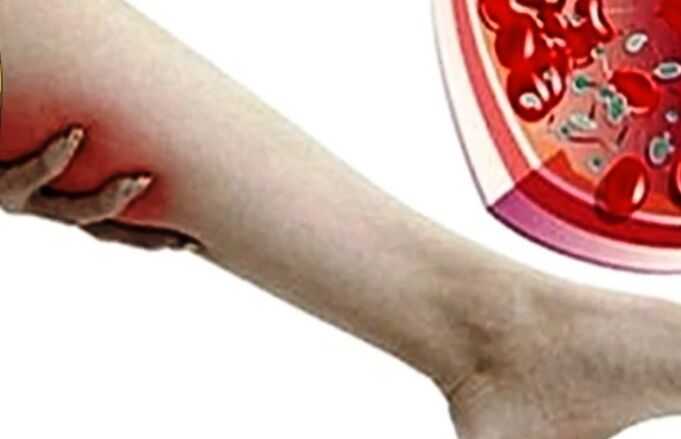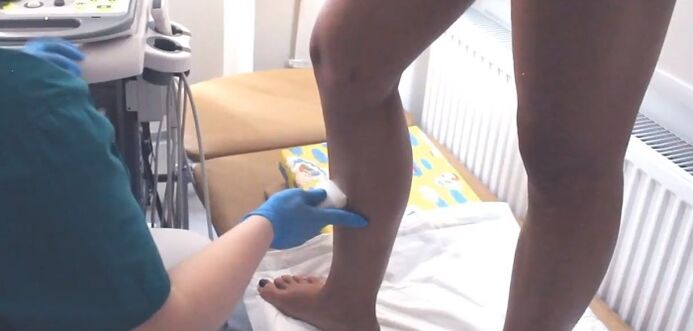The pathological processes that affect the vascular system are a serious risk of the body.This applies to any disease of this kind, regardless of their degree and localization.In particular, this applies to varicose veins, which in most cases affects the foot dishes.
In the modern world, varicose veins are one of the current problems, many people undergo its development.Pathology is not just a cosmetic problem, damage to the foot vessels has severe consequences.Therefore, it is important to understand the mechanisms of varicose veins development, recognize its symptoms, and also have ideas about treatment.
Varicose vein development mechanism
Varicose veins or varicose veins are called a disease in which the vessels mentioned are subject to pathological changes in the following nature:
- Enlargement, that is, an increase in the lumen of the ship.
- Extension, or more precisely, extension of the vein.
- The thinning of the vascular wall, due to which the vein becomes more fragile and is more prone to physical damage.
- The exhaustion or gradual destruction of the valve apparatus, which plays a crucial role in the process of transporting blood again in the heart.
- In the late stages of the disease due to the deformation of the veins, nodules or "vascular stars" that resemble aneurysms.
All the violations described lead to two types of consequences, aesthetic and functional, where the second type is much more weight.If we talk about the aesthetic factor, we are talking about the fact that subcutaneous vessels grow in size, swell and appear closer to the surface of the skin, which is why they become clearly visible with the free eye.As the disease progresses and the increase in vein deformity, they begin to resemble hugs, the joints appear, which exacerbates the aesthetic appearance even more.

But functional problems are more serious and dangerous, because we are talking about a violation of the main vein function - blood transport from the organs to the heart.Varicosis contributes to stagnant ship processes, due to valve impoverishment, blood is not fully evacuated, stagnant.This leads to local toxic lesions, as well as a gradual increase in vessel pressure.After all, in the later stages of the disease, vessels cannot withstand excessive pressure, tears appear on the thin walls, which leads to hemorrhage, the formation of hematomas and trophic ulcers.
Classification of varicose veins
The above has repeatedly stated that the degree of damage and deformation of the veins depends on the stage of progression of the disease.Therefore, it is worth noting that it is common to classify varicose veins according to the three stages of development:
- The first and easiest form of the disease is compensatory.It is characterized by minor deformity, often it is often impossible to determine without proper diagnosis.The symptoms in this case are scarce or completely missing.
- Subcompensation or middle phase - veins appear on the surface of the skin, an increase, such as deformation, are irrelevant.However, vessels and vascular nets are already clearly visible, and in patients' evenings, an increased feeling of fatigue, explosion, swelling, minor pain may be disturbed.It is characteristic that until morning (after night sleep or long -term rest) the symptoms disappear.
- The decompensation phase is the most severe - we are talking about a serious loss of veins, their pronounced deformity.The vessels are not only very visible, they look like tubercles and stick to the surface of the skin, nodules appear, eczema, hematomas appear.Symptoms described in the form of pain, edema and other unpleasant sensations intensify.
It is important to realize that initially varicose veins do not pose a serious risk and over time the start of treatment prevents the progression of the disease.But if treatment is not engaged, there is a high risk of complications, among which thrombosis, inflammatory processes in the veins, trophic ulcers formation, persistent pain syndrome.
The factors of the development of the disease
Recognition of the causes and factors that predisposition to the development of varicose veins not only help in the fight against the pathological process, but also prevent its development.These reasons and factors are as follows:
- Genetic predisposition - in this case, we are talking about a hereditary predisposition to the weakness of the venous valves, as well as the underdevelopment of the connective tissue of the vascular walls.Such developmental abnormalities increase the development of varicose veins, as the valve apparatus is initially subjected to functional disorders.
- Professional component - the risk group is also directed by people who, due to their professional activity, are forced to spend a long time on foot, especially those who cost a lot (hairdressing, seller, chefs, surgeons, etc.).
- Excess weight
 - Excessive weight accumulation leads to increased legs, moreover, in this case, the blood cholesterol level increases, which also adversely affects the functioning of the vascular system.The higher the rate of overweight, the more possible the fact of developing varicose veins.
- Excessive weight accumulation leads to increased legs, moreover, in this case, the blood cholesterol level increases, which also adversely affects the functioning of the vascular system.The higher the rate of overweight, the more possible the fact of developing varicose veins. - Contribute to the appearance of varicose veins enlargement of the blood coagulation pathology.Due to the increase in blood platelets, blood becomes more viscous, there is a risk of blood clots.All this prevents normal blood circulation, causing varicose veins.
- Another factor in the development of the disease is serious hormonal disorders.Women are most affected by such problems, especially during pregnancy, menopause or hormone medication.
The list shows only the main factors in the development of varicose veins, in fact there are much more.For example, we add inappropriate shoes or walk to high heels, alcoholism, smoking, diabetes, mechanical damage to blood vessels, etc.
Clinical
Very often, varicose veins in early forms of development may not appear at all, symptoms appear in 2-3 stages of the progression of the disease.However, it is worth considering the symptoms, starting from the first signs:
- The first symptom that indicates the appearance of varicose veins is foot fatigue.Initially, this feeling is irrelevant, it makes yourself feel mostly in the evening.But as the disease develops, fatigue is worried more and more often, it becomes more intense.
- Feeling of squeezing and pain - begins to worry from the second phase, initially closer to the evening, and in the morning they disappear completely.But as before, with the advancement of varicose veins, they become more intense, ultimately anxious.
- Prolonged veins and vascular nets - this feature also becomes increasingly clear as the pathological process takes place.Initially, the veins are simply visible stronger than usual, in the later stages they climb, tubercles, "stars" shapes appear.
- Ellingance - they can start to disturb immediately, in such cases their reasons seem incomprehensible, and swelling itself is so irrelevant that they practically do not feel.Over time, the legs swell more and more, which causes a lot of discomfort and increases the pain.
- Convulsions - it is believed that if a person is systematically strives by convulsions that cover the calf muscles or foot, it can also be signs of varicose veins.
- Hyperthermia - occurs in the late stages of the development of the disease and is expressed in a change in skin color, the skin on the feet becomes cyanotic.
Diagnostic methods
To treat varicose veins, as effective as possible, an accurate understanding of which stage of development is the disease and evaluation of the degree of hemodynamics.To do this, you need to go through a number of diagnostic measures:

- Initial examination, during which the doctor detects the patient's complaints, collects an anamnesis, and also performs a visual examination and palpation of problems with problems.
- Ultrasound scan for acquaintance with the dynamic characteristics of blood flow.
- Double vein scanning is one of the most informative diagnostic methods that provides a detailed visual appearance of blood flow velocity in different parts of the vascular canal.
- Flebography using a contrast subject, which is inserted into the studied veins.
Treatment of Varicose veins
The fight against varicose veins of any severity requires contact a phleolologist who will make a treatment regimen based on the diagnostic data.
Drug therapy
The main effect expected of taking medication is a decrease in pressure in the veins by eliminating stagnant processes, restoring normal blood circulation.Moreover, in the context of therapy, symptomatic treatment may be required.In general, the doctor may prescribe medicines of such groups:
- Venotonics and phlebotonics - designed to improve lymph exit and normalization of blood circulation, perform the main task of treatment.
- NSAID group drugs - stop painful sensations, and also have an anti -inflammatory effect.
- Anticoagulants to reduce blood viscosity and prevent thrombosis.
- Also, people with varicose veins are recommended to wear special compression linen.
Only a doctor is committed to determining the need to use any medicine and its appointment.Moreover, medication therapy just does not allow the disease to progress, it is impossible to turn into deformed vessels with conservative treatment methods.
Traditional medicine
Folk remedies are unable to have a therapeutic effect just as serious as traditional methods of medicine.However, "grandmother's recipes" is a great help in drug treatment, so we will consider some of the most effective recipes:
- Tomato compresses-cut off sliced tomatoes and attach areas with problems for 15-20 minutes.Tomatoes contain a carotenoid pigment that promotes strengthening and toning veins.
- You can make a potato compress, for this, place your feet with potato cleaning and tie it for 2 hours.The same method works with the use of cabbage and calanchoe leaves, but cuttings should be made on these plants.
- It is also recommended to rub your feet with apple cider vinegar daily before bedtime, the course of treatment is 30 days.
Surgical treatment
Surgery in the fight against varicose veins is the most effective method that radically solves the problem, and not just the restriction of the disease.Surgical treatment methods include:
- Sclerotherapy - the introduction of a special substance into the venous lumen that glues the container, as a result of which disappears independently, replaced by connective tissue.
- Laser exposure is applicable to blood vessels located near the surface of the skin.Laser radiation creates the effect of sclerosis in Vienna, as a result of which the ship disappears.
- Flebectomy - the site dress deformed the vein with the subsequent removal of its luggage.
